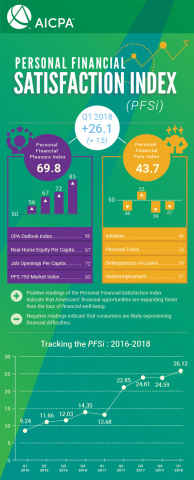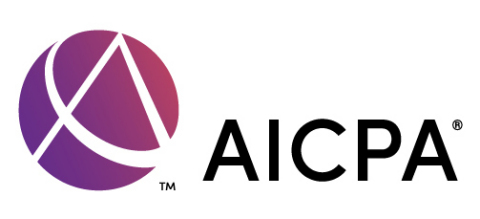NEW YORK--(BUSINESS WIRE)--The extreme volatility that brought the stock market down in the first quarter of 2018 was narrowly offset by the positive effects of lower taxes. This allowed Americans’ personal financial satisfaction to advance to a new record high, according to the AICPA’s Q1 2018 Personal Financial Satisfaction Index (PFSi) released today. This is the first quarter to reflect the impact of the Tax Cuts and Jobs Act and in it, the PFSi increased 1.5 points (6.2 percent) over Q4 2017 to reach 26.1, a new all-time high. This positive reading indicates that the average American is feeling a strong sense of financial well-being.
The positive gains to the overall PFSi were buoyed by personal taxes decreasing 4.2 points (7.3 percent) from the prior quarter which gave many working Americans an increase in their paycheck. The personal taxes component is one of four factors that make up the Personal Financial Pain Index. Thanks largely to the decline in personal taxes, the Personal Financial Pain Index measured 43.7 in Q1 2018, a 1 point (2.1 percent) decrease from the prior quarter. The lower overall value of the Pain Index helped to boost the modest improvement in the PFSi.
Even though taxes declined in the first quarter, they continue to be the largest contributor to financial pain, now for the eighth quarter in a row. The tax component of the Pain Index is particularly important when measuring financial satisfaction because it is a distinct factor that many Americans recognize. When income taxes change, Americans tend to notice because it impacts their take home pay. The personal taxes value uses information from the Bureau of Labor Statistics on income tax, tax on realized net capital gains and taxes on personal property.
“As Americans appreciate an increase to their take home pay, they should recognize that the changes in tax law went far beyond a reduction to income taxes,” said Dave Cherill, CPA, member of the AICPA Personal Financial Planning Executive Committee. “There are countless provisions in the new law that can help middle class families create and secure wealth for themselves and future generations, but many of the new rules expire at the end of 2025. Educating oneself and planning should start now.”
The Q1 2018 Personal Financial Pleasure Index measured 69.8, which is a slight 0.6 point (0.8 percent) increase over the prior quarter. Market volatility was uncharacteristically absent for 2017 but it returned dramatically during the first quarter of 2018. The PFS 750 Market Index declined for the first time since Q3 2015, dropping 3.5 points (3.9 percent) from its Q4 2017 level to 85 and ending its streak of successive record high quarters at four. Despite this, it remains the leading contributor to the Pleasure Index.
“As Americans begin to feel increased market volatility, it’s important to resist the urge to time the market and instead remain focused on a long-term financial plan,” said Robert Westley, CPA/PFS, member of the AICPA Personal Financial Specialist Credential Committee. “A strong financial plan will help to align an investor’s portfolio with their personal financial goals and corresponding time horizons. As the need to draw from a portfolio approaches, investors should begin decreasing their portfolio’s risk. This is especially important for Americans near or at retirement age since bull markets, like the one we have been experiencing, often cause investors to overlook the importance of holding safer investments in their portfolios.”
The other three factors of the Pleasure Index all improved, most notably job openings per capita which increased 3.4 points (4.9 percent) over the last quarter and set a new all-time record as overall job openings totaled 6.3 million in January. The greatest job availability was in professional and business services, transportation, warehousing, utilities, and construction.
The PFSi 's numbers are in sync with Americans' overall attitudes about their personal finances. An April 2018 telephone survey, conducted on behalf of the AICPA by The Harris Poll, found that more than two-thirds of Americans (68 percent) are satisfied with their personal finances which is a slight increase from a year ago when the 2017 study found 64 percent were financially satisfied. In contrast, a little more than a quarter of Americans (28 percent) said they are not financially satisfied, with 14 percent saying not at all. This is a drop from a year ago when slightly more than a third of Americans (35 percent) reported that they were not financially satisfied, with 16 percent saying not at all.
Additionally, more than twice as many Americans (39 percent) said that their personal financial satisfaction has improved over the past year, compared to those who said it has declined (17 percent). However, it was status quo for a sizable number as 41 percent said satisfaction levels remained about the same.
Additional Findings from the Q1 2018 PFSi:
- The AICPA CPA Outlook Index, which captures the expectations of CPA executives in the year ahead for their companies and the U.S. economy, saw an increase of 1.9 points (3.4 percent) above the previous quarter, finishing Q1 with a value of 56. The strongest factors in the level of the Q1 2018 index are US Economic Outlook and Revenue.
- The Real Home Equity per Capita Index, at 67, is still 14.5 percent below its 2006 all-time high. The changes in value have been due to increases in the market value of real estate exceeding increases in mortgages outstanding.
- Underemployment is 8.2 percent, down 2.9 percent from the Q4 2017 level. In comparison, its peak value was 17.1 percent in the fourth quarter of 2009. It is now 1.8% below its average value in the two years before the great recession. Unemployment decreased in almost all industrial sectors over the last year.
- Delinquencies on Loans Q1 level is 2.3 percent below the previous quarter’s level. All the improvements quarterly are due to delinquencies on mortgages. Though the Q1 reading of delinquencies on mortgages (3.54 percent) is well below the peak delinquency rate for mortgages (11.26 percent) set in the spring of 2010, it is still above what was typical between 1994 through 2003 (2.12 percent).
- The blended inflation measure for Q1 is 1.8 percent, which is still below the Federal Reserve’s 2 percent target for inflation. In terms of the index, the Q1 index value is 46, up a slight 0.5 percent from Q4. Inflation is the most volatile factor contributing to the PFSi, and with absolute levels so low, small changes result in large percent gains. The Q1 measure relies on the February level.
Additional information on the PFSi can be found at: www.aicpa.org/PFSi.
Personal Financial Satisfaction Index Methodology
The Personal Financial Satisfaction Index (PFSi) is the result of two component sub-indexes. It is calculated as the difference between the Personal Financial Pleasure Index and the Personal Financial Pain Index. These are comprised of four equally weighted factors, each of which measure the growth of assets and opportunities, in the case of the Pleasure Index, and the erosion of assets and opportunities, in the case of the Pain Index.
The Harris Poll Methodology
The cited survey was conducted on behalf of AICPA by The Harris Poll by telephone within the United States between April 5 and 8, 2018, among 1,014 adults (510 men and 504 women aged 18 and over) including 414 interviews from the landline sample and 600 interviews from the cell phone sample. The 2017 study was conducted by telephone between March 24 and 27, 2017, among 1,018 adults (505 men and 513 women aged 18 and over) including 518 interviews from the landline sample and 500 interviews from the cell phone sample. Results were weighted (using data from the Current Population Survey) where necessary to bring them into line with their actual proportions in the population.
About the AICPA’s PFP Division
The AICPA’s Personal Financial Planning (PFP) Section is the premier provider of information, tools, advocacy, and guidance for CPAs who specialize in providing estate, tax, retirement, risk management, and investment planning advice to individuals, families, and business owners. The primary objective of the PFP Section is to support its members by providing resources that enable them to perform valuable PFP services in the highest professional manner.
CPA financial planners are held to the highest ethical standards and are uniquely able to integrate their extensive knowledge of tax and business planning with all areas of personal financial planning to provide objective and comprehensive guidance for their clients. The AICPA offers the Personal Financial Specialist (PFS) credential exclusively to CPAs who have demonstrated their expertise in personal financial planning through testing, experience and learning, enabling them to gain competence and confidence in PFP disciplines.
About the American Institute of CPAs
The American Institute of CPAs (AICPA) is the world’s largest member association representing the CPA profession, with more than 418,000 members in 143 countries, and a history of serving the public interest since 1887. AICPA members represent many areas of practice, including business and industry, public practice, government, education and consulting. The AICPA sets ethical standards for its members and U.S. auditing standards for private companies, nonprofit organizations, federal, state and local governments. It develops and grades the Uniform CPA Examination, offers specialized credentials, builds the pipeline of future talent and drives professional competency development to advance the vitality, relevance and quality of the profession.
The AICPA maintains offices in New York, Washington, DC, Durham, NC, and Ewing, NJ.
Media representatives are invited to visit the AICPA Press Center at www.aicpa.org/press
About the Association of International Certified Professional Accountants
The Association of International Certified Professional Accountants (the Association) is the most influential body of professional accountants, combining the strengths of the American Institute of CPAs (AICPA) and The Chartered Institute of Management Accountants (CIMA) to power opportunity, trust and prosperity for people, businesses and economies worldwide. It represents 650,000 members and students in public and management accounting and advocates for the public interest and business sustainability on current and emerging issues. With broad reach, rigor and resources, the Association advances the reputation, employability and quality of CPAs, CGMAs and accounting and finance professionals globally.




